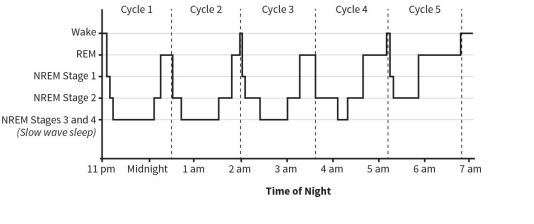REM sleep is a critical stage of your sleep cycle tied to dreaming, memory, and emotional health.

REM sleep, or Rapid Eye Movement sleep, is one of the most fascinating and vital stages of the sleep cycle. It’s named for the quick, darting movements of the eyes that occur beneath closed eyelids during this phase. But REM sleep is much more than eye activity — it’s a period marked by intense brain activity, vivid dreaming, and unique physiological changes. While your body remains still, your brain becomes almost as active as when you're awake.
REM sleep is one of several stages in a full sleep cycle, typically occurring in 90-minute intervals throughout the night. As the night progresses, REM phases become longer, with the most extended and restorative periods happening closer to morning. Understanding REM sleep is essential because it's deeply tied to memory consolidation, emotional regulation, and mental clarity. Whether you wake up feeling refreshed or groggy can often be traced back to the quality and timing of your REM sleep.
REM sleep stands for Rapid Eye Movement sleep, named for the quick, jerky movements your eyes make during this stage. It’s one of several stages in the sleep cycle, distinguished by high brain activity that closely resembles waking patterns.
During REM, your brain is highly active, but your muscles are mostly paralyzed—a state called muscle atonia—which prevents you from physically acting out your dreams. This stage is quite different from deep, slow-wave sleep, where the brain is much less active and the body is fully relaxed.
During REM sleep, your brain exhibits activity patterns that closely resemble those when you’re awake, with fast, irregular waves showing heightened processing. At the same time, your body experiences muscle atonia, a temporary paralysis caused by neurotransmitters that inhibit motor neurons, keeping you from physically acting out your dreams.
REM sleep occurs in cycles throughout the night, typically starting about 90 minutes after falling asleep and repeating every 90 to 120 minutes, with each period gradually getting longer as the night progresses. REM Sleep is only one of the stages of sleep, the others being NREM Sleep.

REM sleep plays a crucial role in consolidating memories and enhancing learning by helping the brain process and store information gathered during the day. It also supports emotional regulation, allowing the brain to manage stress and mood, which contributes to overall mental health. Beyond the mind, REM sleep is linked to physical restoration and brain development, especially during childhood, helping maintain healthy brain function and supporting growth and repair processes throughout life.
While REM sleep is known for its intense brain activity and dreaming, it follows cycles of NREM (Non-Rapid Eye Movement) sleep — a stage that is deeper and more physically restorative. NREM sleep helps repair tissues, strengthen the immune system, and conserve energy. Together, these two stages of sleep serve different but complementary roles: NREM prepares the body, and REM fine-tunes the brain. For truly restorative sleep, both are essential and work in balance across the night.
REM sleep can be influenced by a variety of factors, including age—since the amount of REM sleep tends to decrease as we get older—and certain sleep disorders that disrupt normal sleep patterns. Substances like alcohol, caffeine, and some medications can also interfere with REM by altering brain chemistry or sleep architecture.
Additionally, lifestyle factors such as stress, inconsistent sleep schedules, and exposure to screens before bedtime can reduce the quality and duration of REM sleep, making it harder for your brain and body to fully benefit from this important stage.
REM sleep works alongside deep, slow-wave sleep to create a balanced and restorative sleep cycle. While slow-wave sleep is key for physical repair and immune function, REM sleep supports brain processes like memory and emotional health.
Together, these stages help you wake up feeling refreshed and mentally sharp. When REM sleep is disrupted, it can lead to daytime difficulties such as poor concentration, mood swings, and increased fatigue, affecting overall daily performance and well-being.
When REM sleep is disrupted, people often experience vivid or disturbing dreams and may wake feeling tired despite spending enough time in bed. This disruption can lead to difficulties with memory, reduced emotional resilience, and mood swings.
Certain conditions, such as REM sleep behavior disorder, involve a breakdown of the normal muscle paralysis during REM, causing people to physically act out their dreams. Understanding these disruptions highlights the important role REM plays in maintaining healthy brain and emotional function.
Supporting healthy REM sleep starts with good sleep hygiene—practices like minimizing screen time before bed, keeping your bedroom cool and dark, and avoiding caffeine or heavy meals late in the day. Consistent sleep schedules, where you go to bed and wake up at the same time every day, also help maintain regular REM cycles.
In some cases, therapies such as chronotherapy, which gradually adjusts sleep timing, can assist in realigning disrupted sleep patterns. While individual needs vary, creating a stable and supportive sleep environment is key to promoting restorative REM sleep.
REM sleep is a vital stage of the sleep cycle, essential for memory consolidation, emotional balance, and physical restoration. Its unique brain activity and muscle paralysis distinguish it from other sleep phases, highlighting its specialized role in overall health.
Understanding REM sleep and the factors that influence it can empower you to make choices that support better rest and daily functioning. Staying curious and aware of your sleep patterns is an important step toward improving your well-being.
Matthew Walker, 2017, Why We Sleep